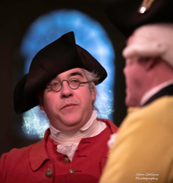"The Embattled British Column: British Tactics on the Battle Road"
November 9, 2020
1:15pm
Presented by Jim Hollister via Zoom webinar.
The program is free and open to the public, but you will need to sign up here.
November 9, 2020
1:15pm
Presented by Jim Hollister via Zoom webinar.
The program is free and open to the public, but you will need to sign up here.

The common image of the British soldier in April 1775 is an automaton, too stiff and too Old World to know how to fight a war in North America. Jim Hollister, Living History Coordinator at Minute Man National Historic Park, intends to shatter that image on Monday, November 9, at 1:15 p.m. by Zoom conference.
“The British lack of warfighting skills in North America is completely not true,” Hollister declares. “General Gage fought in the French and Indian War with George Washington and was himself a strong proponent of Light Infantry, which was already in use in Europe. They established light infantry training camps. They knew how to adapt to the terrain, spread out, take cover, skirmish with the enemy, and focus on marksmanship.”
Hollister has been studying military treatises (officer’s manuals) and firsthand accounts of the British march from Concord for years. He participated in an archaeological dig at the site of Parker’s Revenge that pinpointed the fighting positions of the British and the Colonists and revealed new information about the battle techniques on both sides.
According to Hollister, If the British had marched in traditional fashion on their return from Concord, they would have been entirely picked off before reaching Lexington: “By the end of the day, they were outnumbered three to one and still made it out. Truly, they were a formidable enemy. The fighting on the Battle Road was not a Red Coat turkey shoot. Both sides inflicted a lot of damage.”
In normal times, Minute Man National Historic Park hosts 1.2 million visitors from around the globe. As Park liaison with the reenactment community, Hollister is deeply involved in planning the annual Patriot's Day events. Cancelling Patriots Day activities this year was a heartrending decision. While the Park has limited its offerings during the COVID-19 outbreak, Jim and his fellow rangers have created a strong digital presence with an online inventory of educational videos, battle site explorations and other programs. “That’s where our audience is,” he says.
Jim Hollister always had a passion for history. One day in 1994, fascinated with a group of military reenactors in a parade in his home town of Sharon, he signed up. “Little did I know it would lead to a career,” he muses. He volunteered with the National Park Service and worked as an educator at the Concord Museum and Old Manse before entering the National Park Service in 2002 as a seasonal interpreter at Minute Man. He accepted a permanent position in 2005. In addition to serving as living history coordinator, he also oversees the education, historic weapons and digital media programs.
Jim and the Park will play a key role in Revolution 250, America’s celebration of the founding of our nation, beginning in 2025 and culminating in 2026 with America 250.
“The British lack of warfighting skills in North America is completely not true,” Hollister declares. “General Gage fought in the French and Indian War with George Washington and was himself a strong proponent of Light Infantry, which was already in use in Europe. They established light infantry training camps. They knew how to adapt to the terrain, spread out, take cover, skirmish with the enemy, and focus on marksmanship.”
Hollister has been studying military treatises (officer’s manuals) and firsthand accounts of the British march from Concord for years. He participated in an archaeological dig at the site of Parker’s Revenge that pinpointed the fighting positions of the British and the Colonists and revealed new information about the battle techniques on both sides.
According to Hollister, If the British had marched in traditional fashion on their return from Concord, they would have been entirely picked off before reaching Lexington: “By the end of the day, they were outnumbered three to one and still made it out. Truly, they were a formidable enemy. The fighting on the Battle Road was not a Red Coat turkey shoot. Both sides inflicted a lot of damage.”
In normal times, Minute Man National Historic Park hosts 1.2 million visitors from around the globe. As Park liaison with the reenactment community, Hollister is deeply involved in planning the annual Patriot's Day events. Cancelling Patriots Day activities this year was a heartrending decision. While the Park has limited its offerings during the COVID-19 outbreak, Jim and his fellow rangers have created a strong digital presence with an online inventory of educational videos, battle site explorations and other programs. “That’s where our audience is,” he says.
Jim Hollister always had a passion for history. One day in 1994, fascinated with a group of military reenactors in a parade in his home town of Sharon, he signed up. “Little did I know it would lead to a career,” he muses. He volunteered with the National Park Service and worked as an educator at the Concord Museum and Old Manse before entering the National Park Service in 2002 as a seasonal interpreter at Minute Man. He accepted a permanent position in 2005. In addition to serving as living history coordinator, he also oversees the education, historic weapons and digital media programs.
Jim and the Park will play a key role in Revolution 250, America’s celebration of the founding of our nation, beginning in 2025 and culminating in 2026 with America 250.